Actually, my ship with about 72 square meters (main and working jib on 7/8 rig) with nominally 6.3 to, factually probably more than 7 to weight, quite well sailed. In the wind I have to reef the mainsail from 15 kn at the latest. I don’t have a spinnaker and one is out of the question because I sail a lot single-handed and don’t trust myself to handle a spinnaker alone. In broad reach (> approx. 120 degrees AWA) and aft wind directions I can spread out the jib and from approx. 12 kn wind the ship then runs quite well. However, the mainsail presses and chafes quite a bit on the somewhat aft-swept spreaders at these courses.
In order to gain more propulsion on these courses in weaker winds, I have long flirted with a roll-up gennaker. However, this would have required a gennaker pole, for which I could not come up with a simple and good solution, even after a long period of tinkering. In addition, a gennaker would help in broad reach, but not in aft winds. Finally, last summer, on a longer rough course from Sassnitz past Bornholm towards Karlskrona, I was confidently overtaken by a yacht of about the same size only under a Parasailor sail with the characteristic wing, which doesn’t happen to me often. I had about 2 hours to look at the boat and the sail. This aroused my interest and gave me the impetus to look into this type of sail.
The first thing that amazed me during the research was how large the range of wind direction and strength should be that such a sail can cover according to the manufacturer. The specifications are more or less the same for the two manufacturers in question, ISTEC and Oxley. I use here the representation of Oxley, because I decided at the end of the decision process for the Oxley Bora and am so far very satisfied with it.
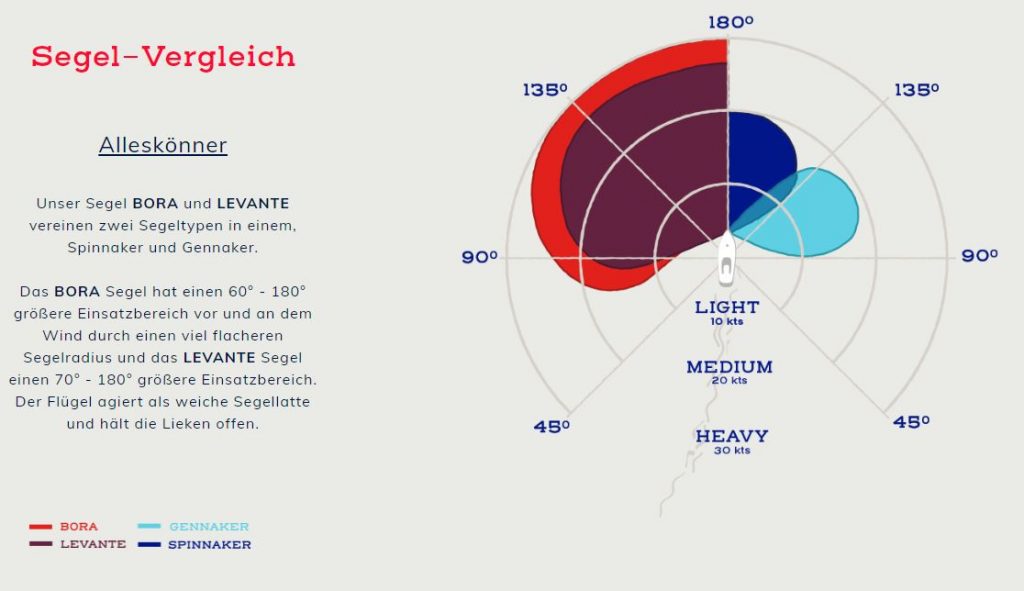
If this information is even close to correct, it makes no sense for me as a cruising sailor to buy 2 sails (spinnaker and gennaker) instead of a parasailor and keep them ready on board.
As a single-handed or small crew sailor, the function of the wing with its stabilizing effect convinces me. In gusts, the sail is stabilized and pulled upwards just like the bow of the ship, and at the same time the gap functions like a valve through which excess wind pressure can escape in the first moment. This should provide favorable conditions for control by the autopilot and lower demands on the handling of the sail.
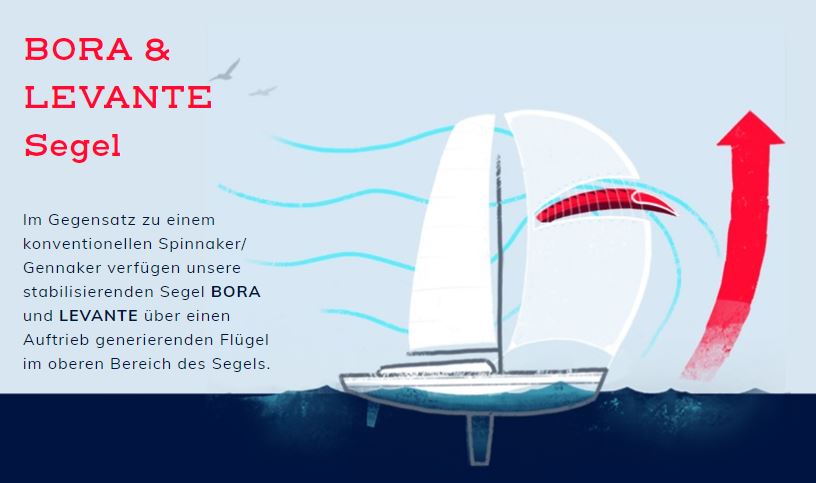
I then decided on the Bora from Oxley because I got good and pleasant advice there right away. A contact person who was available by phone and had a plausible and honest answer to every question. For example, that the sails are made in Sri Lanka in an established sail loft that specializes in the production of kite sails. And that the sails are test-fitted in a special wind tunnel after completion to ensure that the wing in particular is cleanly worked and functions smoothly. I also found the ability to speak without much ado with another private customer who is using the sail in similar application scenarios as I plan to. Overall, I found the advice very good and instructive in terms of size and colors, as well as subsequent handling and required equipment. A size change, which I still had to arrange due to a measurement error after placing the order, could be realized uncomplicatedly and quickly. I decided on the Bora with a length of 13.35 m and a sail area of just under 90 square meters.
Yes, and then about 3 months after the order was placed in January, a huge box was delivered. The sail was in its own bag, next to it the recovery hose with inflatable funnel and pre-mounted recovery line, sail bag as well as air pump and shackle. Of course, I wanted to unpack and check the sail as quickly as possible and then also maneuver it into the recovery tube to have it ready and set in the summer. It’s just not that easy at this size, at least not in a normal apartment. Fortunately I was able to use the rooms of a yoga school and so really completely unfold and check the sail.
During this packing, I was able to see practically every seam and get a good impression of the quality of workmanship. However, the sheer size of the sail then also gave me a fair amount of respect. In the months that followed, I walked past the large sail bag almost every day and asked myself – again and again and sometimes with some trepidation – whether and how I would be able to set this hulk up on my own in the summer and get it down again in one piece.
Then finally in June on an early summer trip to Sweden it is so far. One morning there is a light SW around 6 kn, the sea is calm and smooth and I dare to set sail for the first time. One-handed. While the ship moves slowly forward under engine and autopilot, I put on the sheets and the downhauls. For the downhauls I have attached 2 snatch blocks to the forward anchor fitting, from where the downhauls and to the cockpit are led. The sheets are diverted port and starboard at the stern by blocks to the winches. That’s quite a lot of lines gathering on deck and in the cockpit, and they need to be sorted. I decided on this variant to be able to jibe quickly and easily from the cockpit.
Next, I pull the recovery hose up from the fore hatch on the spinnaker halyard and secure the recovery hose provisionally with the recovery line on a cleat. Then I pump up the funnel with a few strokes and attach the sheets and downhaul to the color-coded clews. I bring the ship to a headwind course of about 120 degrees AWA and fix the downhaul and sheet accordingly, so that the sail is correctly positioned as soon as possible after setting. Then it’s time. Slowly and carefully I pull up the recovery hose. At first the sail falls loosely and lightly out of the upwardly rising recovery tube until the wind gradually fills it and helps it along. About in the middle it falters briefly, because with the wing altogether more cloth balls up at this place. A slight jerk and pull is enough and the rest of the sail is now also out and blown by the wind. The recovery line is occupied and it goes back to the cockpit. Course to the wind and sheet settings fit, so that the sail adhoc first halfway stands and pulls easily but steadily at 4 – 6 kn AWS.

I’m overwhelmed at first, because it was so easy. Then I start to finely trim the sheets and optimize the sail position. The boat purrs along and I’m amazed at the stability of the wing, which spreads the sail apart very nicely even in this light wind. On this first attempt, I get to about 90 degrees AWA before the luff starts to get bumpy. Due to the higher course, the apparent wind now increases to 6 – 8 kn and you can already clearly feel the power in the sail at the sheet. The ship is now running at 5 knots. At the same time, the wind turns more and more to the west, so that I can’t keep my course parallel to the coast and slowly get too close to land.
So now I have to recover the bora. I return to a clear course and open the sheet. While the sail is already collapsing, I quickly go to the forecastle and pull the tube down with the recovery line. This goes – at least in this light wind – wonderfully easy and smooth. Contrary to my initial fear, the recovery hose can also be pulled down over the sail with a little jerking and pulling. Then loosen the spinnaker halyard and free the filled recovery hose through the fore hatch into the foreship.
The whole thing took about an hour and I’m thrilled with how well it worked out. It’s a load off my mind, because a sail like that is quite an investment, at least by my standards. A few days later I make a 2nd attempt in similar wind conditions and again everything works wonderfully and smoothly. There are certainly still many small things in the handling, which must grind in and optimization possibilities in the trim. And with more wind pressure, the dynamics will certainly be much higher and the processes must sit accordingly clean, especially when sailing single-handed. But now I feel relatively safe with the sail in winds up to 10 knots and look forward to the next learning steps.
2 Responses to Oxley Bora Parasailor
Leave a Reply to alex Cancel reply
This site uses Akismet to reduce spam. Learn how your comment data is processed.
-
Recent Posts
Recent Comments
- Calypsoskipper on Expose Finngulf 39
- Christian on Expose Finngulf 39
- Calypsoskipper on Expose Finngulf 39
- Kenneth Melcher on Expose Finngulf 39
- alex on Saildrive diaphragm – replace according to instructions or just keep?
Kalender
January 2026 M T W T F S S 1 2 3 4 5 6 7 8 9 10 11 12 13 14 15 16 17 18 19 20 21 22 23 24 25 26 27 28 29 30 31 Tags
12 V Verkabelung 12 V wiring Anchor windlass Ankerwinde Biscaya Bora Segel Bretagne Brittany Camaret sur mer circuit distribution Cornwall Cowes Cuxhaven Den Helder Diaphragm English Channel Falkenberg falkenbergs Båtsällskap Falmouth Gezeitensegeln havarie Hydrogenerator Lewmar Ocean Membrane MiniPlex-3USB-N2K Nordsee Norwegen Oxley Parasailor Plymouth Ramsgate Saildrive Saildrive diaphragm Saildrive Membrane SailingGen Seenotrettung Segeln in Tidengewässern Sjöräddnings Sällskapet Skagen Skagerak Stromkreisverteilung tidal navigation tidal water routing Tidennavigation ÄrmelkanalArchiv
Kategorien

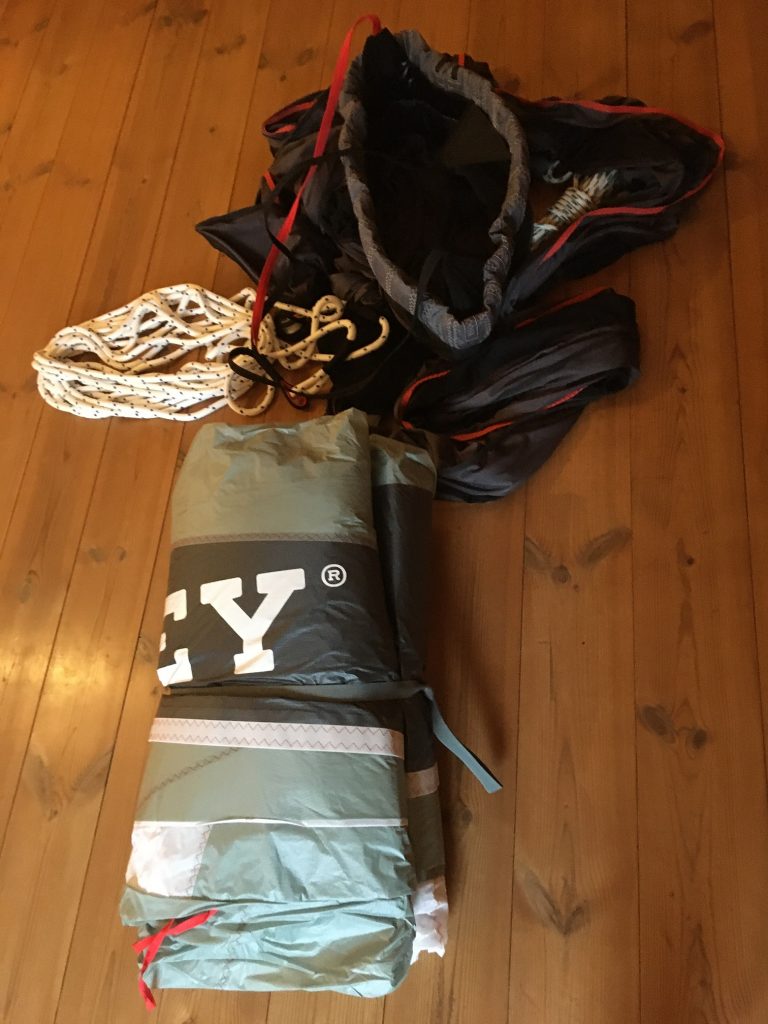
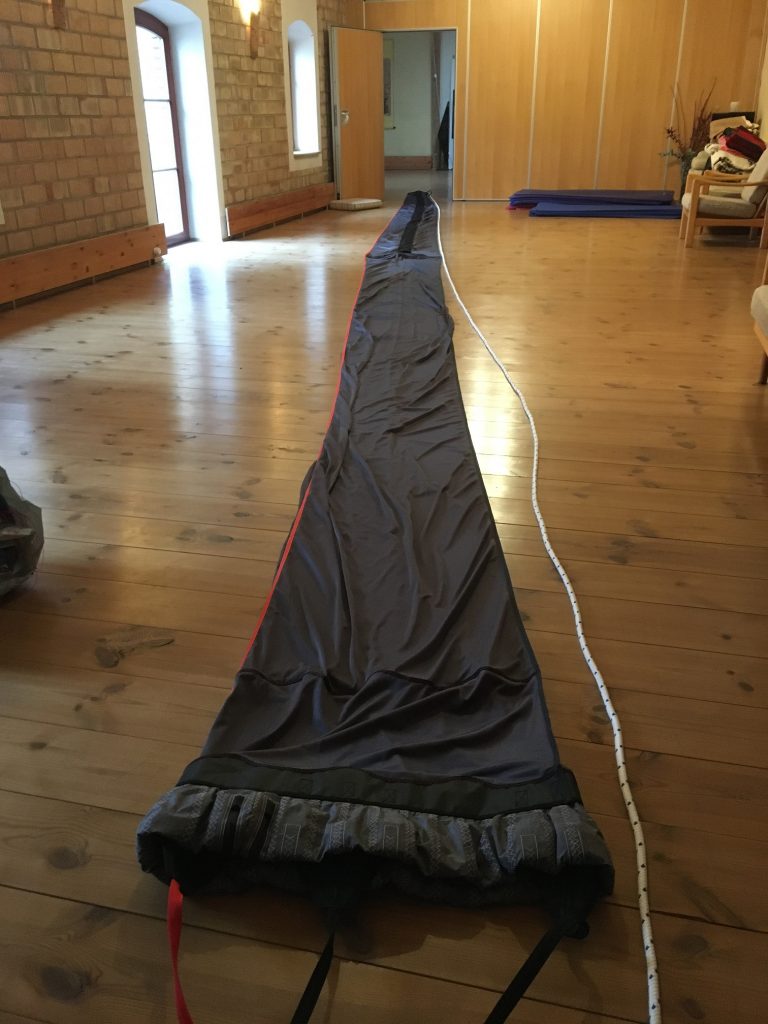
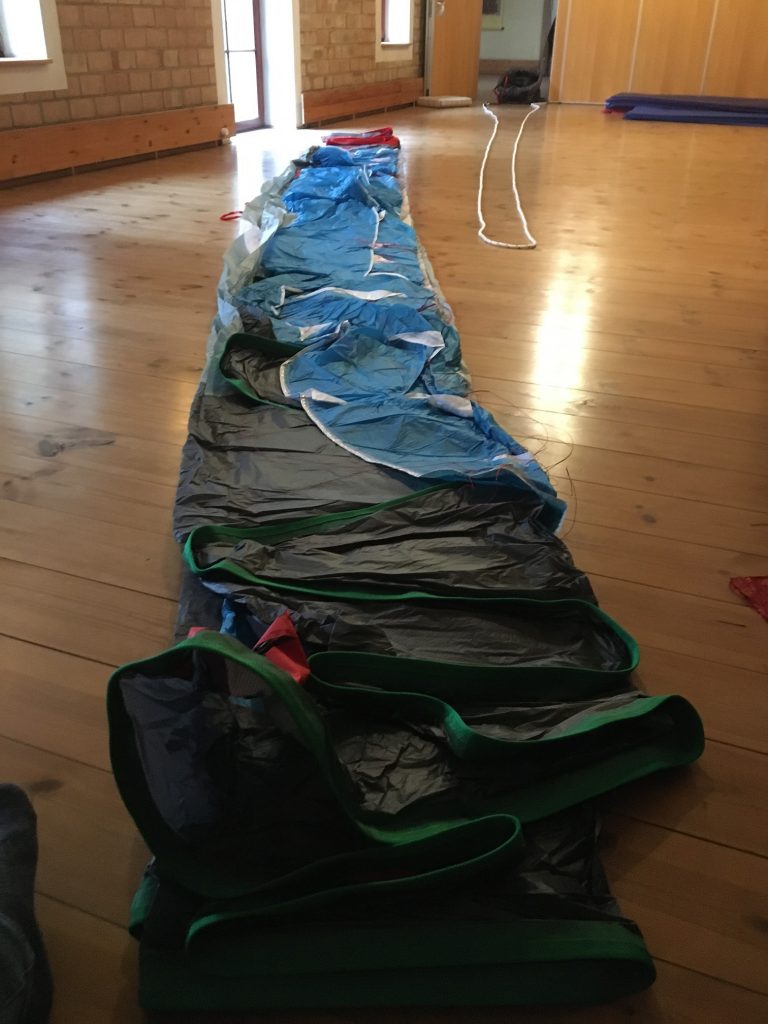
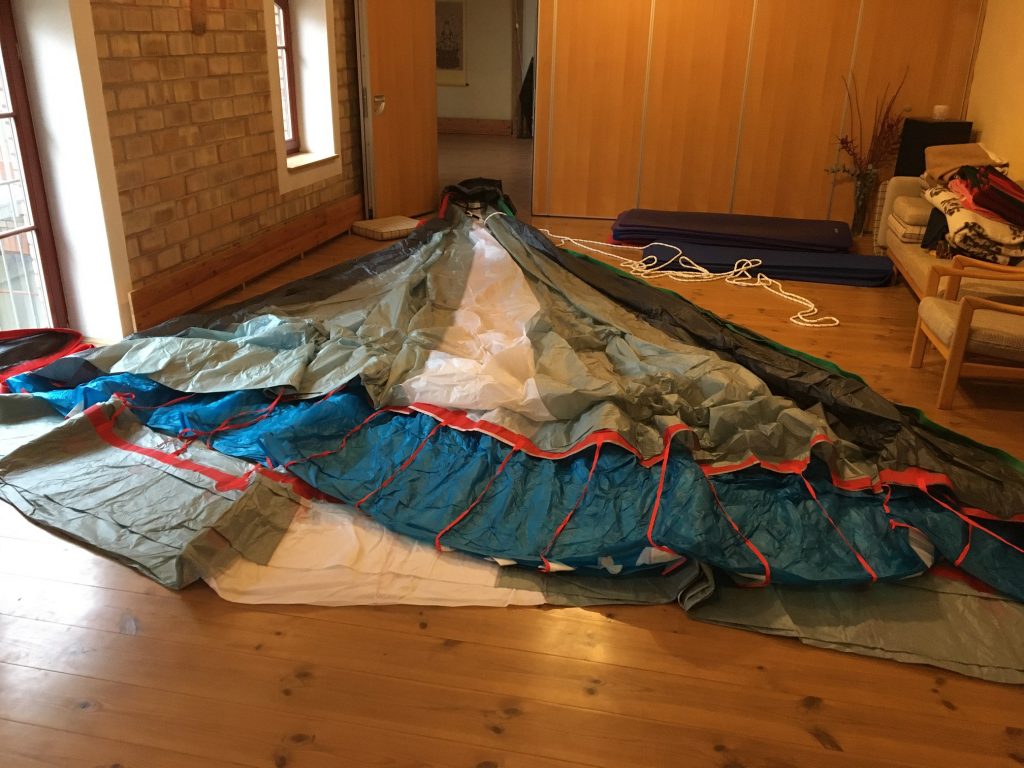
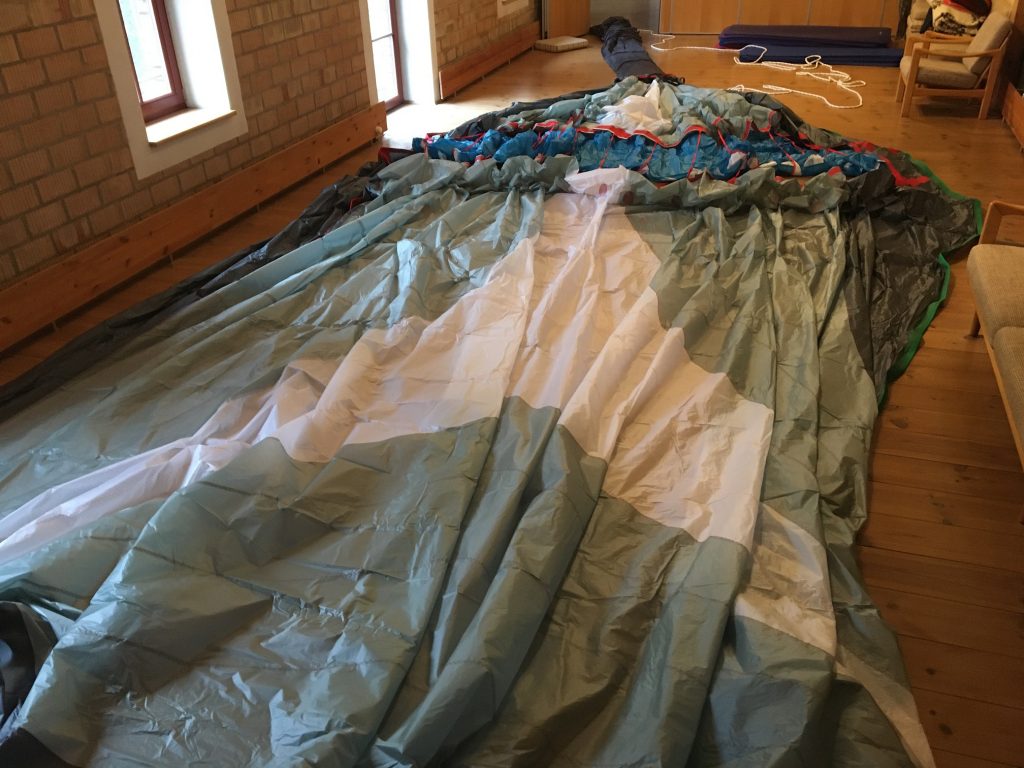
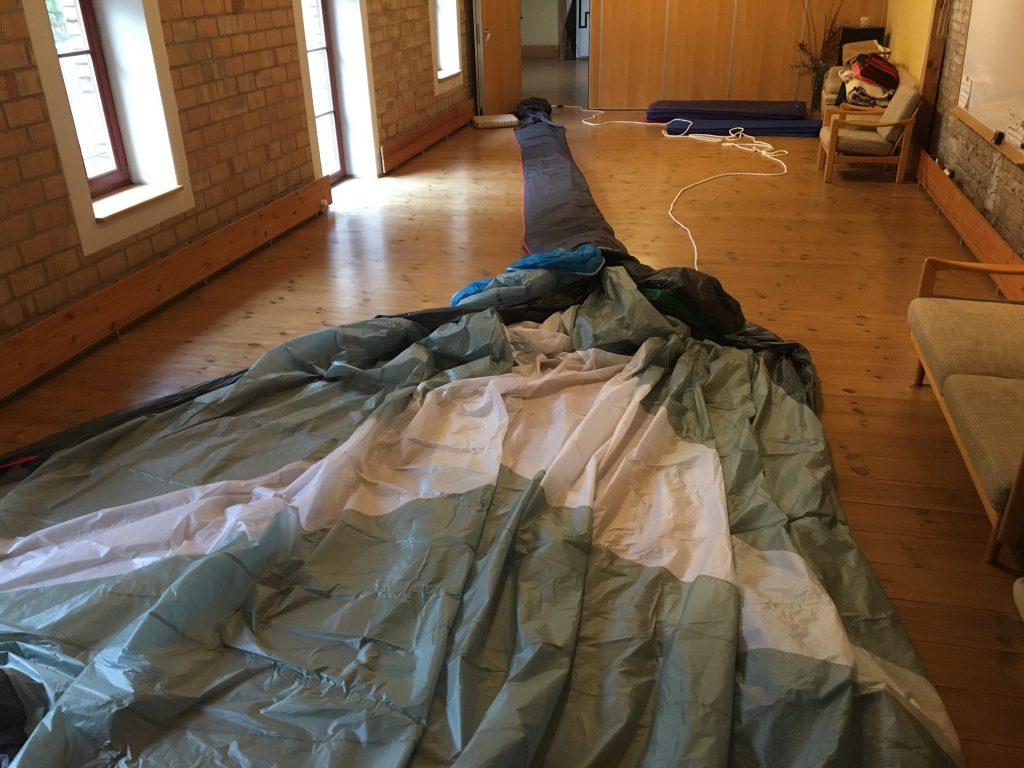
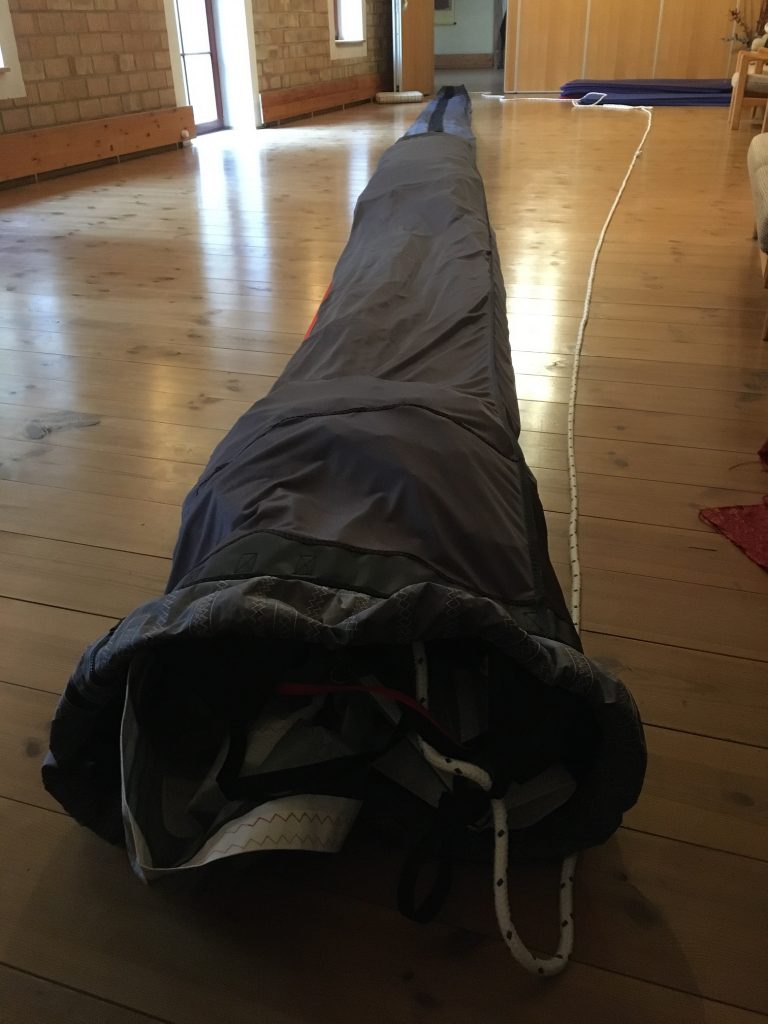
Schöner Beitrag. Wie lange ist das Segel jetzt an Bord? Gibt es schon weitere Erfahrungen?
leichtere Winde? stärkere Winde (maximum?)? Windrichtungen maximum? Setzen und Bergen bei mehr Welle?
ich bin aktuell auch am Recherchieren für ein weiteres Segel- Gennaker mit integrierter Furler-Funktion oder ein Oxley. Aber ich bin vom Setzen/Bergen auf dem Vorschiff mittels Schlauch nicht begeistert – daher meine Fragen 😉
Danke. Habe den Bora eine Saison im Einsatz und bei Winden bis 8 Kn AWA und > 120 Grad AWA gesegelt. Da ich überwiegend einhand segele, bin ich eher vorsichtig. Aus meiner Sicht bringt der Bora seine Stärken allerdings auch genau bei eher schwachen Winden und einem AWA > 120 Grad, nämlich dann wenn ein Vorsegel ohnehin einfällt bzw. ausgebaumt werden müsste. Sind dann aber satte 90 statt 72 qm Segelfläche. Ab 15 kn raumen Wind läuft das Schiff auch unter Normalbesegelung nahe Rumpfgeschwindigkeit, da würde mehr Druck nicht viel bringen. Setzen und Bergen mit dem Schlauch ging zumindest unter Leichtwindbedingungen einfacher als ich gedacht hatte. Aber klar, man muss dafür aufs Vorschiff, und genau das will man natürlich bei Wind und Welle nicht.